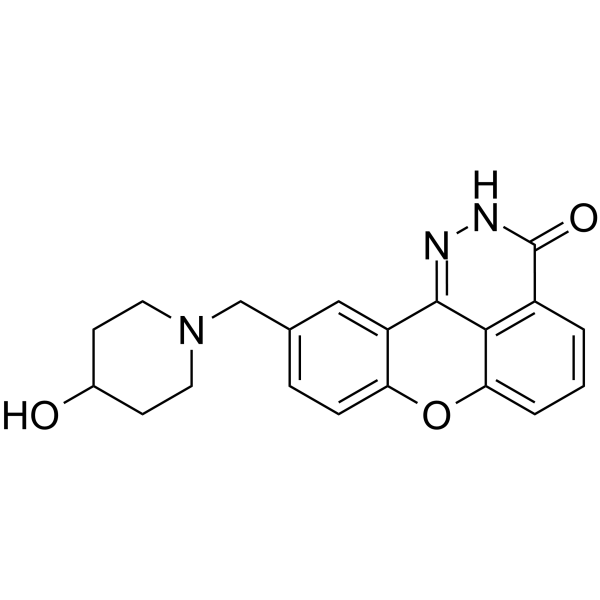902128-92-1
| Name | 10-((4-hydroxypiperidin-1-yl)methyl)chromeno[4,3,2-de]phthalazin-3(2H)-one |
|---|---|
| Synonyms |
E7016
UNII-M8926C7ILX Benzopyrano(4,3,2-de)phthalazin-3(2H)-one,10-((4-hydroxy-1-piperidinyl)methyl) 10-(4-hydroxypiperidin-1-ylmethyl)-2H-7-oxa-1,2-diazabenzo[de]anthracen-3-one |
| Description | E7016 (GPI 21016) is an orally available PARP inhibitor. E7016 can enhance tumor cell radiosensitivity in vitro and in vivo through the inhibition of DNA repair. E7016 acts as a potential anticancer agent[1][2]. |
|---|---|
| Related Catalog | |
| Target |
PARP |
| In Vitro | E7016 can enhance tumor cell radiosensitivity through the inhibition of DNA repair[1]. E7016 (3 μM)-mediated radiosensitization occurs through an increase in the number of cells undergoing mitotic catastrophe and not an increase in the number of cells undergoing apoptosis[1]. E7016 inhibits PARP by mimicking NAD+[2]. Apoptosis Analysis[1] Cell Line: The U251 human glioblastoma cell line Concentration: 3 μM Incubation Time: 6 hours prior to irradiation and were stained at 24 and 72 h postirradiation Result: The number of cells in mitotic catastrophe was significantly greater in the E7016-treated irradiated cells than in cells that received radiation only at 24 hours postirradiation. |
| In Vivo | E7016 has antitumor efficacy in murine xenograft studies[1]. Administration of E7016 (40 mg/kg; oral gavage) to mice bearing U251 xenografts enhances the effectiveness of the Temozolomide/radiation combination[1]. Mice treated with E7016/irradiation/Temozolomide have an additional growth delay of six days compared with the combination of Temozolomide and irradiation in vivo[1]. Animal Model: Four- to six-week-old female nude mice[3] Dosage: 40 mg/kg Administration: Oral gavage Result: E7016 enhanced the radiation/Temozolomide (3 mg/kg orally)-induced tumor growth delay of U251 xenografts. |
| References |
| Molecular Formula | C20H19N3O3 |
|---|---|
| Molecular Weight | 349.38300 |
| Exact Mass | 349.14300 |
| PSA | 78.71000 |
| LogP | 3.00270 |
